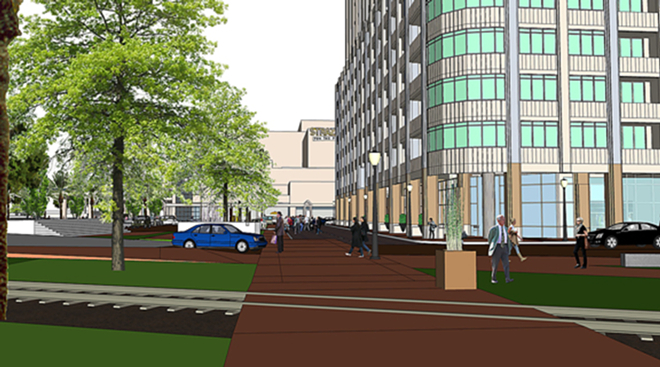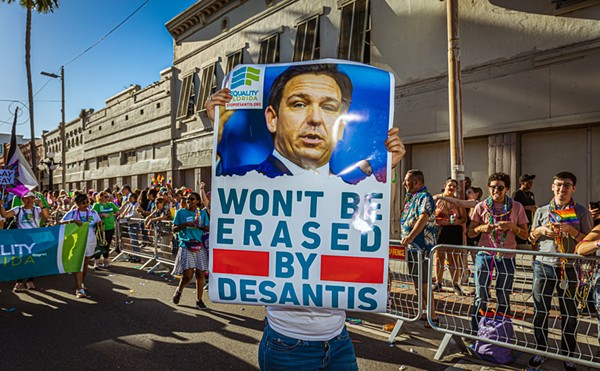
Tampa’s downtown has had a protracted adolescence, all gawkiness and unrealized potential. But in the last three years, with the opening of the Tampa Museum of Art, the Glazer Children’s Museum and Curtis Hixon Riverfront Park (designed by landscape architect Thomas Balsley), the core has been evolving.
Urban form has never been Tampa’s strong suit. At times it feels like for every forward stride, like the playful fountains in the park, we make a design blunder, like the crafty un-urban design on Zack Street. (Pam should have stopped while she was ahead). Villareal’s ethereal light art on the Tampa Museum’s facade is stunning; the rough-textured symbols embedded in the crosswalks of Zack Street are plain silly and clumsy.
Harry Wolf, architect extraordinaire, won international acclaim for his design of Rivergate Tower, the round building whose limestone-clad elegant design was originally complemented by Kiley Gardens. Unfortunately, this formerly verdant garden must be referred to as Kiley Flatlands, because who’s ever heard of a garden with no flowers and no trees?
Flash: The absolute best view in Tampa is on the third level of the Cube adjoining the Rivergate Tower. Look north from the Florida Museum of Photographic Arts space past treeless Kiley (where you can still vaguely discern the sophisticated pattern of walkways and allees) toward the Tampa Museum of Art, on up to the Straz. Wow!
On Aug. 8th, Tampa City Council will vote on a transformative proposal just up the street. Called the “Residences at the Riverwalk,” this 36-story structure, placed between the library and the Straz, will introduce 500 new residents and ground-floor retail and restaurants into the cultural hub of downtown.
The proposal has been chewed over, vetted and finally blessed by the Straz Center board, the American Institute of Architects, the Tampa Downtown Partnership, and the Friends of the Riverwalk. The Straz board, initially fearing that the project could disrupt access to the center, wrangled some significant concessions from the Intown Group, the project developers.
The elevated pedestrian bridge between the garage, the library and the Straz will be retained, and construction will be delayed until May to avoid disrupting the performing arts center’s Broadway series. In a generous if strategic gesture, the developers are contributing $1 million to the Straz Center to use as they will.
So what’s this building going to look like?
The ground level facing west and north will have a covered pedestrian arcade with views of the Hillsborough River and the Straz Center and cafes. The renderings provided by the developers are pretty generic; no architect’s name has been attached to this project.
Both of the downtown residential high-rises previously developed by the Intown Group (Skypoint and Element) are “design-neutral” in my book. They are clean, but rich in neither materials or details, and with no pedestrian protection in the form of awnings or overhangs. I hope that the higher profile of this project, with its proximity to Stanley Saitowitz’s museum and across from the audacious minarets of the University of Tampa, will challenge the Intown Group to up their design game.
Most people will experience the Residences at the Riverwalk as pedestrians, so the street feel needs to be very thoughtfully created. The scale and location of the “back of building” features from truck loading to garbage collection require careful planning to minimize the visual and olfactory effects. The 620 parking spaces provided for the 380 apartments need to be accessed easily, but not dominate the street level. Given Tampa’s thunderstorm tendencies, shade and shelter need to be the bywords for the pedestrian arcades, which could be the building’s best feature.
The very best parts of the Residences’ proposal are the improvements to the adjacent streets, paid for with the $4 million the City of Tampa will receive for the land. With the construction of the interstate in the 1960s, Tyler and Cass streets became a highly dysfunctional two-way pair. Now imagine two redesigned streets which are two-way and part of the Green Spine, a reworking of Cass Street to provide bicyclists and pedestrians a safe roadway, unshared with cars. This transformative Green Spine will link West Tampa’s Homer Hesterly Armory building with Ybor City’s Cuscaden Pool.
Tampa City Council members need to safeguard the sale of this public land by asking tough, specific questions of both the developers and the mayor: Will the city administration commit the $4 million revenue to be spent immediately and directly on the Cass and Tyler Street improvements? When will the Green Spine be built? What will the pedestrian arcade’s design be: height, width, materials? The vehicular access points? Dumpsters? The site plans need to clearly commit these questions to writing.
The Residences at the Riverwalk can spark another growth spurt for Tampa’s urban center, raising our profile, extending our reach, evolving our stature — if they’re done right.
CLARIFICATION: An earlier version of this story said that the Tampa Museum of Art was among the organizations that have blessed Residences at the Riverwalk. The museum sent this clarification: "The Board of Trustees of the Tampa Museum of Art endorses development that will complement the Riverwalk and River Arts District but has not, as of this date, endorsed this specific project."

















